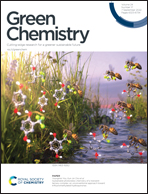Life cycle assessment of enzymatic poly(ethylene terephthalate) recycling†
Abstract
Enzymatic hydrolysis of poly(ethylene terephthalate) (PET) is a chemical recycling approach intended to enable a circular economy for polyesters. To quantitatively compare this technology to other recycling and synthesis approaches for PET, it is critical to conduct rigorous and transparent process analyses. We recently reported a detailed process model that was used to conduct economic, energy, and greenhouse gas emissions analyses for enzymatic PET recycling. Here, we expand upon this previous work by conducting a process-based life cycle assessment (LCA) of the same enzymatic hydrolysis system, to produce both terephthalic acid (TPA) and ethylene glycol (EG) for use in a closed-loop PET recycling scheme. This LCA shows that enzymatic hydrolysis currently performs 1.2 to 17 times worse than virgin TPA and PET production across most impact categories, excepting ecotoxicity and fossil fuel depletion. The top contributors to these impacts include post-consumer PET collection and processing, sodium hydroxide, and electricity. Sensitivity analysis shows that improving yields throughout the recycling process and eliminating certain process steps, such as amorphization pre-treatment and reaction pH control, can reduce the overall environmental impacts of enzymatic PET recycling to levels statistically equivalent to virgin TPA and PET production, thereby highlighting crucial areas for further research and innovation.



 Please wait while we load your content...
Please wait while we load your content...